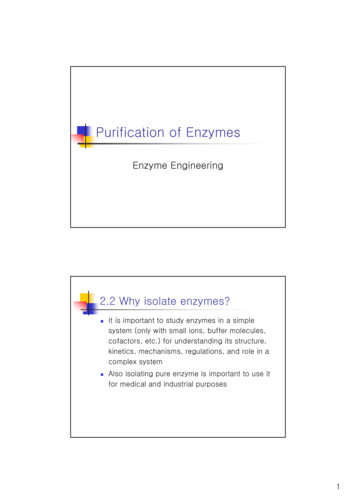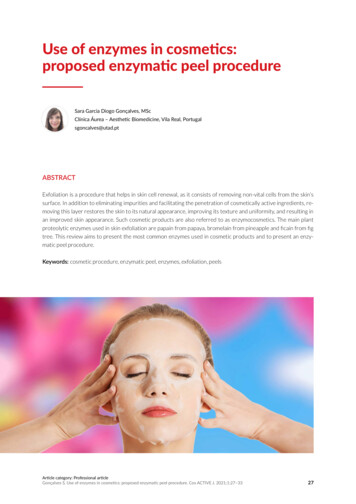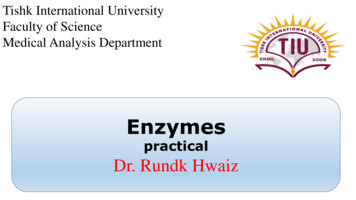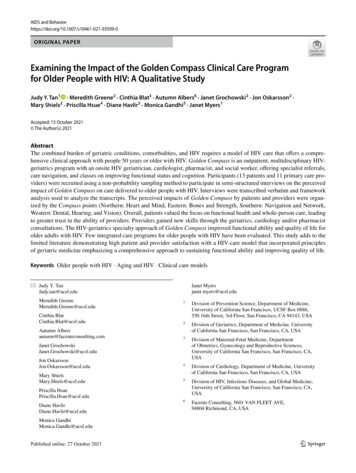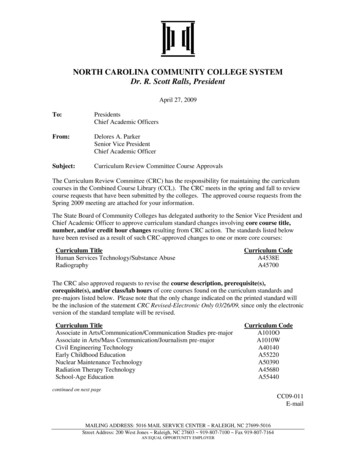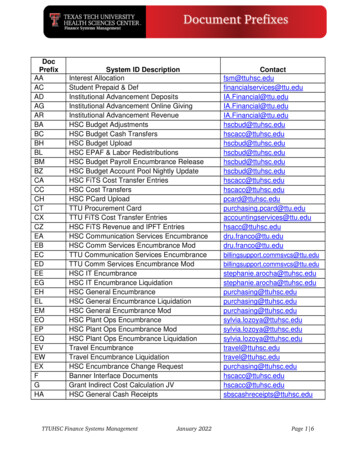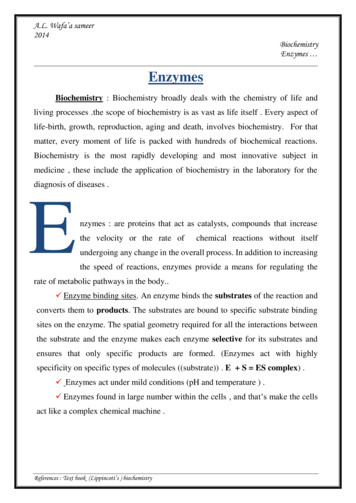
Transcription
A.L. Wafa’a sameer2014BiochemistryEnzymes EnzymesBiochemistry : Biochemistry broadly deals with the chemistry of life andliving processes .the scope of biochemistry is as vast as life itself . Every aspect oflife-birth, growth, reproduction, aging and death, involves biochemistry. For thatmatter, every moment of life is packed with hundreds of biochemical reactions.Biochemistry is the most rapidly developing and most innovative subject inmedicine , these include the application of biochemistry in the laboratory for thediagnosis of diseases .Enzymes : are proteins that act as catalysts, compounds that increasethe velocity or the rate ofchemical reactions without itselfundergoing any change in the overall process. In addition to increasingthe speed of reactions, enzymes provide a means for regulating therate of metabolic pathways in the body. Enzyme binding sites. An enzyme binds the substrates of the reaction andconverts them to products. The substrates are bound to specific substrate bindingsites on the enzyme. The spatial geometry required for all the interactions betweenthe substrate and the enzyme makes each enzyme selective for its substrates andensures that only specific products are formed. (Enzymes act with highlyspecificity on specific types of molecules ((substrate)) . E S ES complex) . Enzymes act under mild conditions (pH and temperature ) . Enzymes found in large number within the cells , and that’s make the cellsact like a complex chemical machine .References : Text book (Lippincott’s ) biochemistry
A.L. Wafa’a sameer2014BiochemistryEnzymes THE ENZYME-CATALYZED REACTIONEnzymes, in general, provide speed, specificity, and regulatory control toreactions in the body. Enzyme-catalyzed reactions have three basic steps:(1) binding of substrate: E S ES complex(2) conversion of bound substrate to bound product: ES EP(3) release of product : EP E PAn enzyme binds the substrates of the reaction it catalyzes and brings themtogether at the right orientation to react. The enzyme then participates in the makingand breaking of bonds required for product formation, releases the products, andreturns to its original state once the reaction is completed.Enzymes do not invent new reactions; they simply make reactions occurfaster. The catalytic power of an enzyme (the rate of the catalyzed reaction dividedby the rate of the uncatalyzed reaction) is usually in the range of 106 to 1014.Without the catalytic power of enzymes, reactions such as those involved innerve conduction, heart contraction, and digestion of food would occur too slowlyfor life to exist.Each enzyme usually catalyzes a specific biochemical reaction. The ability ofan enzyme to select just one substrate and distinguish this substrate from a group ofvery similar compounds is referred to as specificity. The enzyme converts thissubstrate to just one product. The specificity, as well as the speed, of enzymecatalyzed reactions result from the unique sequence of specific amino acids thatform the three-dimensional structure of the enzyme.References : Text book (Lippincott’s ) biochemistry
A.L. Wafa’a sameer2014BiochemistryEnzymes Key and lock model Chemical nature and properties of enzymes1- All the enzymes are invariably proteins.2- Each enzyme has its own tertiary structure and specific conformation whichis very essential for its catalytic activity.3- The functional unit of the enzyme is known as holoenzyme which is oftenmade up of apoenzyme (the protein part) and a coenzyme (non-protein organicpart) .Holoenzyme Apoenzyme Coenzyme(active enzyme)(protein part)(non-protein part)4- The word monomeric enzyme is used if it is made up of a singlepolypeptide e.g. ribonuclease , trypsin. Some of the enzymes which possess morethan one polypeptide (subunit) chain are known as oligomeric enzymes e.g. lactatedehydrogenase, aspartate transcarbamoylase etc.References : Text book (Lippincott’s ) biochemistry
A.L. Wafa’a sameer2014BiochemistryEnzymes Nomenclature of enzymesIn the early days, the enzymes were given names by their discoverers in anarbitrary manner. For example, the names pepsin, trypsin and chymotrypsinconvey no information about the function of the enzyme or the nature of thesubstrate on which they act. The suffix-ase was added to the substrate for naming the enzymes e.g.lipase acts on lipids; nuclease on nucleic acids; lactase on lactose etc , the suffix –ase also can be added to the name of the reaction that the enzyme react e.g.Oxidases , decarboxylases , dehydrogenases etc . Enzymatic reactions divided in to 6 major classes and each have (4-13)subclasses . The additional information that required to express the nature of theenzymatic reaction . Each enzyme has a specific code number called Enzymatic code (EC) thatidentified each of class , subclass , sub-subclass , and the last number refers to thename of enzyme itself . e.g.// 2.7.1.1 [ ATP: D-hexose- 6- phosphotransferase]In that 2 refers to the class ( transferase ) .7 refers to the subclass ( transfer a phosphate group ) .1 refers to the sub-subclass ( refers that alcohol act like phosphateacceptor ) .1 refers to the enzyme ( hexoxinase ) .Which is the enzyme that help in the transferring of phosphate group fromATP to the hydroxyl group on the 6th carbon atom of glucose .References : Text book (Lippincott’s ) biochemistry
A.L. Wafa’a sameer2014BiochemistryEnzymes Classification of EnzymesEnzymes are sometimes considered under two broad categories :(a) Intracellular enzymes- They are functional within cells where they aresynthesized.(b) Extracellular enzymes – These enzymes are active outside the cell; allthe digestive enzymes belong to this group.The International Union of Biochemistry (lUB) appointed an EnzymeCommission in 1961.This committee made a thorough study of the existingenzymes and devised some basic principles for the classification and nomenclatureof enzymes.Enzymes are divided into six major classes in that order . Each class on itsown represents the general type of reaction brought about by the enzymes of thatclass . The six classes of the enzymes are as in the table below :References : Text book (Lippincott’s ) biochemistry
A.L. Wafa’a sameer2014BiochemistryEnzymes 1- Oxidoreductases :Oxidation-reduction reactions are very common inbiochemical pathways and are catalyzed by a broad class of enzymes calledoxidoreductases. Whenever an oxidation-reduction reaction occurs, at least onesubstrate gains electrons and becomes reduced, and another substrate loseselectrons and becomes oxidized.a- One subset of reactions is catalyzed by dehydrogenases, which accept anddonate electrons in the form of hydride ions (H:-) or hydrogen atoms. Usuallyan electron-transferring coenzyme, such as NAD /NADH, acts as an electrondonor or acceptorb- In another subset of reactions, O2 donates either one or both of its oxygenatoms to an acceptor (for example, see xanthine oxidase,). When this occurs,O2 becomes reduced, and an electron donor is oxidized. Enzymesparticipating in reactions with O2 are called * hydroxylases and oxidaseswhen one oxygen atom is incorporated into a substrate and the other oxygenatom into water, or both atoms are incorporated into water. They are called*oxygenases when both atoms of oxygen are incorporated into the acceptor.Most hydroxylases and oxidases require metal ions, such as Fe-2, for electrontransfer.2- Transferases :Transferases catalyze group transfer reactions—thetransfer of a functional group from one molecule to another. If the transferred groupis a high-energy phosphate, the enzyme is a kinase; if the transferred group is acarbohydrate residue, the enzyme is a *Glycosyltransferase; if it is a fatty acylgroup, the enzyme is an *acyltransferase. Another subset of group transfer reactionsconsists of transaminations . In this type of reaction, the nitrogen group from anamino acid is donated to an alpha - keto acid, forming a new amino acid and thealpha - keto acid corresponding to the donor amino acid. Enzymes catalyzing thisReferences : Text book (Lippincott’s ) biochemistry
A.L. Wafa’a sameer2014BiochemistryEnzymes last type of reaction are called *transaminases or aminotransferases. The coenzymepyridoxal phosphate is required for all transaminases . When the physiologicallyimportant aspect of the reaction is the compound synthesized, the transferase may becalled a synthase. For example, the enzyme commonly called glycogen synthasetransfers a glucosyl residue from UDP-glucose to the end of a glycogen molecule.Its systematic name is UDP-glucose-glycogen glycosyltransferase.3- Hydrolases: In hydrolysis reactions, C-O, C-N, or C-S bonds cleaved bythe addition of H2O in the form of OH- and H to the atoms forming the bond . Theenzyme class names specify the group being cleaved (e.g., the enzyme commonlynamed chymotrypsin is a protease, a hydrolase that cleaves peptide bonds inproteins).4- Lyases. The lyase class of enzymes consists of a diverse group of enzymescleaving C-C, C-O, and C-N bonds by means other than hydrolysis or oxidation.Some of the enzymes catalyzing C-C bond cleavage are called *aldolases,*decarboxylases (when carbon dioxide is released from a substrate), and*thiolases (when the sulfur-containing nucleophile of cysteine or CoASH is used tobreak a carbon-carbon bond) .This broad class of enzymes also includes *dehydratases and many*synthases. Dehydratases remove the elements of water from two adjacent carbon–carbon bonds to form a double bond. Certain enzymes in this group, such as certaingroup transferases, are commonly called synthases when the physiologicallyimportant direction of the reaction favors the formation of a carbon–carbon bond(e.g., citrate synthase).5- Isomerases : Many biochemical reactions simply rearrange the existingatoms of a molecule, that is, create isomers of the starting material . Enzymesrearranging the bond structure of a compound are called isomerases, whereasReferences : Text book (Lippincott’s ) biochemistry
A.L. Wafa’a sameer2014BiochemistryEnzymes enzymes catalyzing movement of a phosphate from one atom to another are calledmutases.6- Ligases : Ligases synthesize C-C, C-S, C-O, and C-N bonds in reactionscoupled to the cleavage of a high-energy phosphate bond in ATP or anothernucleotide. Carboxylases, for example, add CO2 to another compound in a reactionrequiring ATP cleavage to provide energy . Most carboxylases require thecoenzyme biotin. Other ligases are named synthetases (e.g., fatty acyl CoAsynthetase). Synthetases differ from the synthases mentioned under “lyases” andgroup “transferases” in that synthetases derive the energy for new bond formationfrom cleavage of high-energy phosphate bonds, and synthases use a different sourceof energy.References : Text book (Lippincott’s ) biochemistry
Biochemistry Enzymes References : Text book (Lippincott's) biochemistry Enzymes Biochemistry: Biochemistry broadly deals with the chemistry of life and living processes .the scope of biochemistry is as vast as life itself . Every aspect of life-birth, growth, reproduction, aging and death, involves biochemistry. For that
